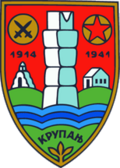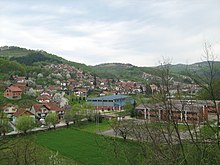Krupanj
|
Крупањ Krupanj |
||||
|
||||
| Basic data | ||||
|---|---|---|---|---|
| State : | Serbia | |||
| Okrug : | Mačva | |||
| Opština : | Krupanj | |||
| Coordinates : | 44 ° 22 ' N , 19 ° 22' E | |||
| Height : | 318 m. i. J. | |||
| Area : | 342 km² | |||
| Residents : | 4,912 (2002) | |||
| Agglomeration : | 20,192 (2002) | |||
| Population density : | 14 inhabitants per km² | |||
| Telephone code : | (+381) 15 | |||
| Postal code : | 15314 | |||
| License plate : | LO | |||
| Structure and administration | ||||
| Community type: | Town | |||
| Structure : | 23 localities | |||
| Mayor : | Dorić Savo ( NS ) | |||
| Postal address : | Maršala Tita 2 15314 Krupanj |
|||
| Website : | ||||
Krupanj ( kyrill. Крупањ) is a city in northwest Serbia and the seat of the large municipality of the same name. It is located in the Mačva district . The large municipality had a population of 20,192 inhabitants in 2002, the city itself 4,912 inhabitants.
geography
The city is located in western Serbia , on the southern edge of the Pannonian Plain and the Mačva region. Krupanj is surrounded by the Jagodnja, Boranja and Sokolska planina mountains, in a valley cut by rivers and streams. The rivers Bogoštica, Čađavica and Kržava flow through the city , they converge north of Krupanj to the river Likodra, which later flows into the Jadar. The city lies at an altitude of 318 m. The parish covers approximately 342 km², and the parish includes 23 villages. Krupanj is the center of the Rađevina region, named after Radj, a knight of the prince and saint Lazar Hrebeljanović , who defended the region from Hungarian and Ottoman conquerors. He is buried near the monument on Rađev Kamen Mountain.
Krupanj municipality
The municipality of Krupanj consists of 23 localities:
- Banjevac
- Bela Crkva
- Bogoštica
- Brezovice
- Brštica
- Cerova
- Cvetulja
- Dvorska
- Kostajnik
- Krasava
- Krupanj
- Kržava
- Likodra
- Lipenović
- Mojkovic
- Planina
- Ravnaya
- Šljivova
- Stave
- Tolisavac
- Tomanj
- Vrbić
- Zavlaka
The community is made up of Orthodox Serbs , but around 200 Slavic Muslims also inhabit Krupanj.
history
The first archaeological finds from the Krupanj area date back to the early Neolithic . Among other things, ceramic objects and an ax made of light white stone were found. In front of the town are the remains of a Roman settlement called Villa Rustika, with some valuable fragments of Roman ceramic work. The name Krupanj was mentioned for the first time in 1417, in the commercial records of the town of Ragusa ( Dubrovnik ), but at that time the town was called Crupagn by Italian traders. In the Middle Ages mining was carried out in Krupanj and the surrounding area, the main metal being removed is silver . So that the city was on one of the trade routes of the merchant caravans from Ragusa. At that time Krupanj was a center of silver mining in the region together with the east Bosnian city of Srebrenica . In 1459 today's Rađevina Oblast, including Krupanj, and the entire Serbian despotate fell under Ottoman rule.
The Church of Dobri Potok (Dobropotočka crkva) on the outskirts of Krupanj, which is dedicated to the Assumption of All Saints Mother of God, was first mentioned in Turkish records in 1528 and is the oldest surviving church in the Podrinje area. Built in the traditional Serbian style, the church houses a variety of records and memorabilia from the time of Ottoman rule and the Serbian Wars of Liberation.
The church is surrounded by a small ethno park with several chapels and museum houses . At the time of the First Serbian Uprising , Krupanj was liberated in the summer of 1804 by the Hajduken under Đorđe Obradović "Ćurčija", and the prince and voivod of Rađev Krsta Ignjatović, who defended Krupanj together with voivod Maksim Krstić , played an important role in the liberation struggle organized. The first elementary school in the city opened in 1837, and the Church of the Ascension of Christ was built in 1842. The Ottomans finally withdrew in 1862 and the nearby Ottoman fortress called "Soko Grad" was demolished in order to build the Serbian Orthodox Monastery of St. Nicholas there. On the orders of Prince Mihailo Obrenović , head of the Rađevina district, in Jar 1862, Captain Peter Radojlović organized the demolition of the fortress. At the end of the 19th century, a lead- antimony smelter was established in the town, among other things a villa was built in which the board of directors of all mine workers in the Podrinje region, Svetozar Mašin, lived with his wife Draga Mašin . Draga Mašin later becomes Queen of Serbia and the wife of King Aleksandar Obrenović . On the Mačkovog Kamen, on Jagodnja Mountain, in the hinterland of Krupanj, one of the great battles between the Serbian army and the Austrian army in World War I was fought . Prince Đorđe Karađorđević was wounded in this battle and the total casualties on both sides amount to around 23,000 people. In memory of this event, a memorial was erected in Krupanj itself at the Serbian Orthodox Church on Ascension Day , and the Orthodox memorial chapel was also erected on Mačkovo Kamen, the site of the battle. The architect was Momir Korunović. In 1922 the first sports club Radjevac was founded in Krupanj in honor of captain Peter Radojlović. in 1927 the Radojlović sports and cultural association was opened, which existed until the Second World War .
During the Second World War, on July 7, 1941, partisan Žikica Jovanović killed two gendarmes in the village of Bela Crkva. In communist Yugoslavia it was the day, the official date of the celebration of the popular uprising against the German occupiers in Serbia. On September 26, 1941, under the chairmanship of Josip Broz Tito, the meeting of the Partisan Main Staff took place in the nearby village of Stolice. A memorial and memorial as well as a park were built after the war to celebrate the event, however this monument has been quite neglected in the recent past. In 1941 the town of Krupanj was one of the centers of the Republic of Užice , the German occupiers set fire to the town of Krupanj at the end of 1941 with the fall of the partisan state of Užice . The historic houses, the pharmacy (formerly the villa of Pero Despić) and the Serbian Orthodox Church on the Ascension of Christ were burned. The hospital, a foundation of the rich businessman Nikole Spasić from Belgrade , was also destroyed. In addition, the German soldiers looted the Orthodox monastery of St. Nicholas, also known as Soko Manastir. In addition, the majority of the Krupanj residents who did not flee were murdered. From 1945 Krupanj belonged to the socialist Yugoslavia. And from 2006 the city lies in the Republic of Serbia.
economy
In addition to the main economic branches, mining and wood processing, the textile industry , cardboard box production, contact lens production and the drying of local fruits developed in Krupanj in the 1960s. Smaller companies dominate the town. Trade and tourism also play an important role in Krupanj's economy.
tourism
Krupanj is one of the underdeveloped municipalities in western Serbia, but the municipality of Krupanj ( Opština ) is clean and is characterized by its wealth of unspoiled nature. Four rivers flow through the valley in which Krupanj lies, spanned by a total of 15 bridges. In addition, the municipality has an abundance of historical monuments and thus offers considerable tourist potential. There are currently two hotels in the city center. The Serbian Orthodox Church of the Assumption of Mary is a rarely preserved sacred building of traditional architecture. Numerous historical monuments from the two world wars have been preserved, including those on Mačkov Kamen and Mount Cer. The Tronoša Orthodox Monastery and the Ethno Park near Tršić preserve the memory of Vuk Stefanović Karadžić , who reformed the Serbian language in the 19th century. There is also a small ski area on the Mačkov Kamen mountain. The area is suitable for hiking and biking, and the numerous streams and rivers are rich in fish , especially trout, so there are also fishing clubs in the area. Numerous sports facilities (including a sports hall and Olympic swimming pool) and a pleasant climate offer pleasant conditions for sports tourism, which are marketed by numerous sports clubs from Serbia and the surrounding countries. The mountainous hinterland of Krupanj with the mountains Jagodnje, Boranja, Sokolska planina and Toranj is ideal for camping and hunting. The town of Krupanj itself with its many parks, the partly newly built old town, the modern cultural building (the work of the architect Ivan Antić), several sports fields, a swimming pool and numerous restaurants, as well as the old churches and the remains of the Roman settlement is also touristy Interesting.
sons and daughters of the town
- Borivoje Ž. Milojević (1885–1967), geographer and academic, the primary school in the village bears his name
- Zlatka Reljić (1929–2007), Minister in Socialist Serbia
- Lavrentije (* 1935), Orthodox metropolitan of the eparchy of Sabac and Valjevo
- Milutin Popović Zahar (* 1938), musician and songwriter
- Dragan Pantelić (* 1951), football player from the Loznica area , went to school in Krupanj
- Njegoš Petrović (* 1999), football player
supporting documents
- Књига 9, Становништво, упоредни преглед броја становника 1948, 1953, 1961, 1971, 1981, 1991, 2002, подаци по насељима, Републички завод за статистику, Београд, мај 2004, ISBN 86-84433-14-9
- Књига 1, Становништво, национална или етничка припадност, подаци по насељима, Репувништво, Репувништво, Репунак, Бурорс33, ISBN , .86,
- Књига 2, Становништво, пол и старост, подаци по насељима, Републички завод за стататистику, Беогеима, ISBN 86, Стататистику,






